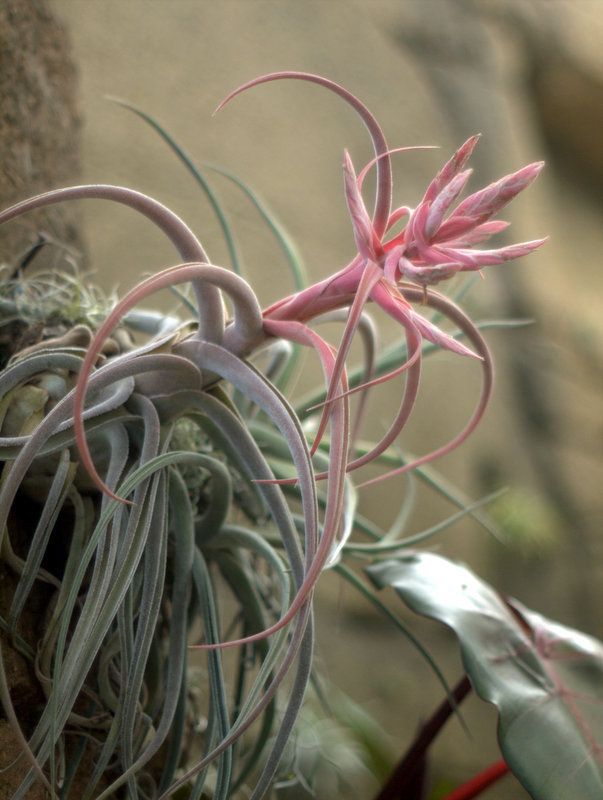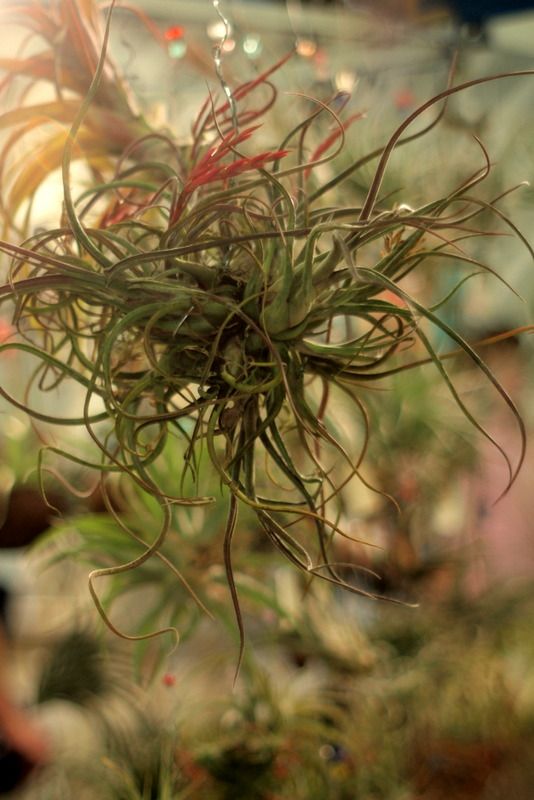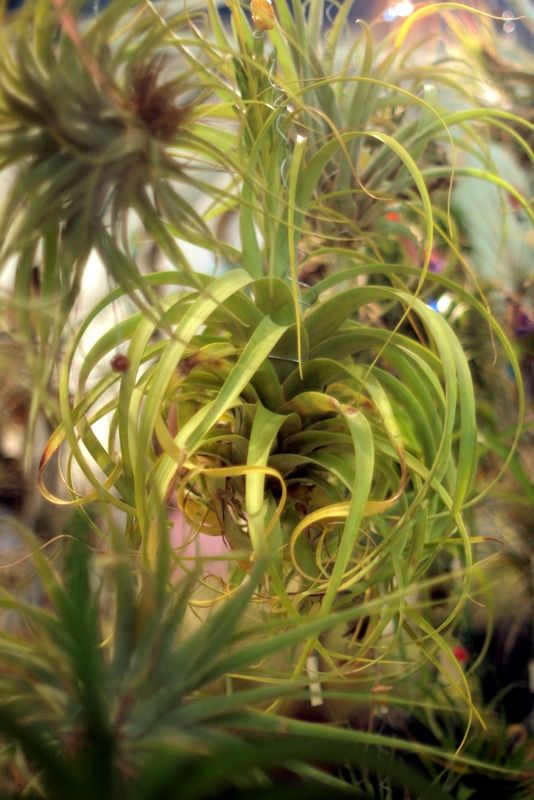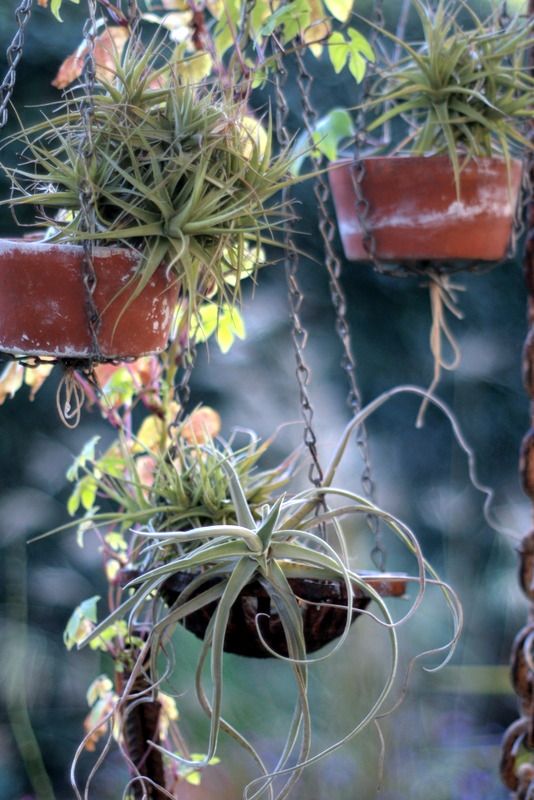
* Tillandsia duratii has the most fragrant flower over the longest period of time. There is currently more demand than supply.
* Tillandsia xerographica’s inflorescence can last up to a year. It has been overcollected in its home of Guatemala.
* Tillandsia aernanthos is the most common, the least expensive, and comes in lots of forms.
* Tillandsia brachycaulos’ deep leaf color lends that trait to colorful hybrids.
* Tillandsia tectorum was used as a model by James Cameron for jellyfish-like creatures in his movie “Avatar.”
* Tillandsia hybrid ‘Curly Slim’ is too beautiful to keep in stock.
I’m a mistress of tillandsia facts after listening to the recording of Paul Isley’s lecture given at our local Long Beach Aquarium of the Pacific last year, link here.
Tillandsias, the so-called air plants, have a leaf structure and surface evolved to handle a drenching amount of moisture without rotting. The most common mistake made growing them indoors is insufficient moisture. (Care instructions here.)
I felt immediate kinship with Mr. Isley upon learning that he inaugurated his adventure in tillandsias 40 years ago in a Jeep Wagoneer which he drove to Guatemala, bringing back seeds and plants to sell at the Pasadena Rose Bowl flea market. We never drove our used Jeep Wagoneer anything close to that distance, but it carried all four of us plus two Newfs for quite some time before the sagging headliner became too irritating to endure. (Next time you see a vintage Jeep Wagoneer check it out — I bet its headliner is sagging. We never could get ours to remain attached.)
Mr. Isley’s nursery in Torrance, Rainforest Flora, is now the largest grower of tillandsias in North America. No longer based on collecting, since 1993 the company has become entirely self-sufficient in producing this notoriously slow-growing bromeliad. A large part of their growing is done in Northern San Diego County.


Tillandsia Tuesday — today’s micro-meme. Grab a drink and a comfy blanket and settle in. The lecture is a soothing 40 minutes’ long.

Again, the link to the lecture can be found link here.
There’s an intro of about 2 minutes, where the word “bromeliad” is mispronounced more times than I would have presumed possible, so you can skip that and go straight to the lecture.

That was an interesting presentation and I appreciate you posting it for us.
Thanks for taking us along to all the wonderful events you frequent. Since I have never been to your part of the world, it gives me a feel for the community in which you reside.
Thanks for that link, much more cheering than watching than the news tonight.
I find RFF’s watering instructions very confusing: “once Tillandsia leaves are wet, more water doesn’t do a thing for them. Wet them and leave them.” seems a complete contradiction to “The most secure way to water the plants indoors is to submerge them for a twelve hour period”, which also seems a whole other contradiction to: “If this area [the crucial center area, the meristematic tissue where new cells are produced] remains too moist for too long the plant may rot.” How long is too long? Soaking for 12 hours doesn’t keep the meristematic tissue moist too long?
I’ve been doing “dip and flip” — dunk them in water and let them dry facing down so the water completely drains out of the “crucial center area”.
I loved this post! I’d no idea that the Long Beach Aquarium sponsored talks – thank you for sharing the link to this one. Now my appetite is whet for a trip to Rainforest.
Thanks for this! I’m excited to give it a listen. Durable no my recent visit to SoCal the name Rainforest Flora came up, sounds like I may need to visit sometime.
Thanks for the link. I enjoyed the presentation, particularly the random end. “Oh, since I have a captive audience, here’s some photos from my trip to the Arctic.” lol
I feel a little better about my Tillandsia duratii after hearing him say they’re slow-growing. I’m trying to keep it better hydrated than I have, though. I just found T. flabellata at a local nursery and it’s my new favorite, at least of the ones I own. Someday I hope to find Tillandsia dyeriana.
Nice post and nice reminder about the store. There are still a a few Tillandsia I want to add to my collection once the weather is warm enough for interstate shipping.
@Judy, I’m so glad you enjoyed that. Thanks for letting me know.
@Hoov, like all plants indoors, there’s that sweet spot of too wet/too dry, and it seems the meristem is the problem area. I don’t grow them indoors since I’m terrible with indoor plants. Outside they seem to be thriving with misting and occasional dunking. I think the instructions are nuanced but sound, since these guys are spectacularly successful growers.
@Kris, we need to meet up there!
@Loree, it’s located on an unpromising stretch of the huge retail corridor of Hawthorne Blvd., so I passed it for years without knowing of it existence. Yes, worth a visit!
@Evan, you’re way ahead of me! I’ve never bothered with memorizing the various species and just bought on impulse, which is why I appreciated this vide.
@Tim, good shipping weather will be here before you know it!